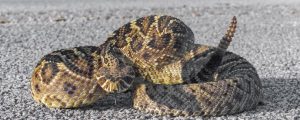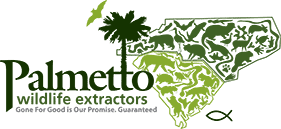It has been estimated that there are 37 various species of snakes throughout the State of North Carolina. Despite the fact that a bite may prove to be painful, 31 species are non-venomous. A total of 6 species are venomous. These are found in a variety of habitats – from forests, to swamps, to lakes.
In this particular article, we are going to focus on the top 3 most venomous snakes to be concerned over when it comes to the State of North Carolina. Continue reading to learn more.
-
The Eastern Copperhead
The Eastern Copperhead lives in deciduous forests, woodlands that are mixed, and outcroppings that are relatively rocky. They are most active during the daytime hours throughout the spring and during the cooler weather during the fall. In the summer months, this snake is nocturnal.
Considered to be an “ambush hunter”, the Eastern Copperhead selects an area and waits in order to bring the element of surprise to its prey. They may sense the size of their prey through an organ between the eyes that senses heat. The snakes are pit vipers. Most bites – which are dry and warnings – contain very little venom; therefore, the bite is rarely fatal.
-
The Eastern Diamond Back Rattlesnake
The Eastern Diamond Back Rattlesnake is considered to be both the heaviest and the longest of all venomous snakes located throughout the State of North Carolina. While these snakes prefer habitats that are dry, they may be found on the borders of the state’s wetlands, in prairies that contain water, and are commonly seen in the savannas.
They are most active in the morning time and in the evening time. These snakes will make the rattle sound – in most instances – prior to striking their prey. They are capable of striking two-thirds of their total body length.
-
The Cottonmouth
Cottonmouth snakes are semi-aquatic snakes that are venomous. Many refer to them as being a “water moccasin”. These snakes are commonly found in the Coastal Plain region.
They are common to freshwater habitats – such as the river floodplains, the cypress swamps, and wetlands that contain a lot of vegetation. They are active during the day and at night. They forage for their food after dark when it is hot outside. These snakes are considered to be “pit vipers”.
While the venom of this particular snake is considered to be very powerful, a bite is rarely lethal. That is, if help is sought immediately. If help is not sought immediately, yes, the bite from a cottonmouth may prove to be fatal.
Conclusion
As you can see, there are several venomous snakes throughout the State of North Carolina. In addition to those outlined in this guide, there other examples. These include – but are not limited to – the Timber Rattlesnake, the Northern Water snake, Queen snake, and the Glossy Swamp snake.
If you experience issues with unwanted snakes on your property, contact us here at Palmetto Wildlife Extractors immediately by calling: 855-465-1088

